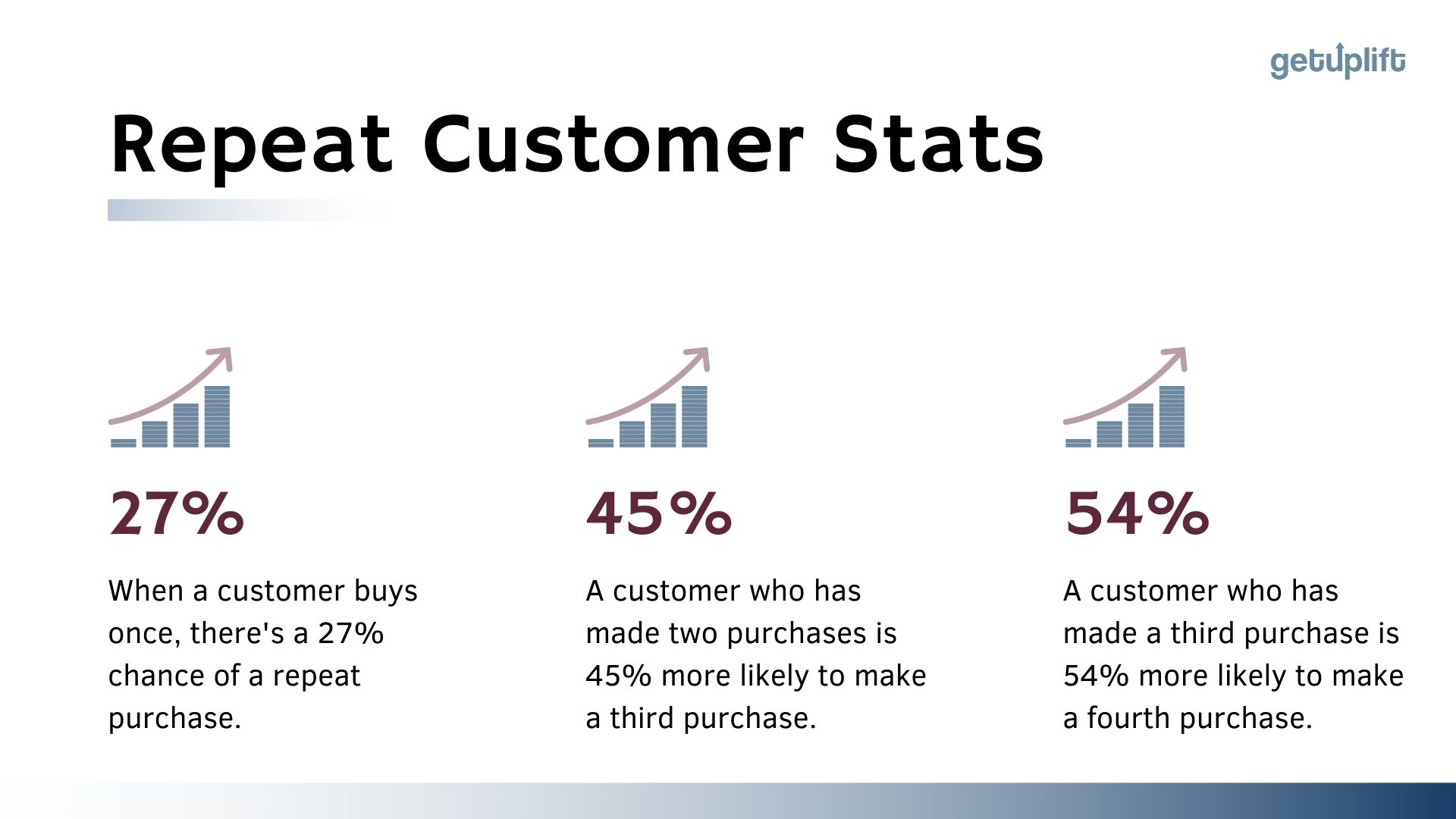This may not surprise you, but it can be almost 7 times more cost effective to retain an existing customer than acquire a new one. (Markin Blog, 2020)
Turns out, the probability of an existing customer making a purchase is about 60-70 percent. Your likelihood of a sale only lies between 5-20 percent for new prospects. (Markin Blog, 2020).

In fact, companies lose $1.6 trillion when customers take their business elsewhere. (Markin Blog, 2020))
Clearly, the case has been made for focusing on customer retention.
There’s one very simple concept we need to internalize though before we dive into understanding strategies for customer retention. If they’re buying more from you, they’re buying less from someone else, and quite possibly ending a long-term buying relationship.
Oftentimes, the discussion around customer retention devolves into quick and simple tactics to get people to make their second purchase faster. But, it can be more complicated than that.
For all you know, there could be long established personal narratives as to why a person buys one brand over another. Through this lens, the simple act of switching laundry detergents could represent a falling out with one’s mother, which is why you have to pay careful attention to your customer retention strategy.
You’re not just getting to the second purchase. You’re trying to change your customer’s buying habits and connect with them on a deeper level. Essentially, you must understand your potential customer’s perspective, biases, needs and concerns and then use that knowledge to create a better customer journey that will increase customer retention.
Table of Contents
So, What Makes Customers Buy More?
At the end of the day, we are creatures of habit.
Psychologically, our brains prefer consistency and tend to repeat our previous actions.
In fact, many purchases are made as we sleep-walk through the aisles. We gravitate to our default websites in the same way we grab our favorite brand of milk, toilet paper and paper towels without giving the others so much as a glance.
This is most commonly known as the status quo bias. Offline or online, if you’ve previously purchased something at an online store, you know it works and how long it takes and, over time, you come to trust this service and prefer to keep with it, even if you know there’s a better bargain elsewhere.
If you want to improve customer retention and loyalty, you need to understand the habits people have constructed around other brands so that you can break them and use them in your favor.
Gusto, a payroll tech company, is a good example of how changing consumer habits improves customer retention and loyalty. Gusto was a small startup in 2011 competing against payroll tech giants such as QuickBooks and Square. There was only one way for Gusto to become a strong competitor; use a different strategy.
They use content to fill knowledge gaps, and free tools to provide value their audience loves. They have millions of organic website visitors because they cover topics that speak directly to their customers’ needs in a way their competitors don’t.
Also, they’ve created localized paycheck calculators that get over 600,000 organic visits each year because they solve a specific problem for their target audience. In fact, these were tools people had to buy before Gusto came on the scene.
So, Gusto has essentially created content and tools that attract people to them and also encourage them to stay. People using their tools for free will keep coming back to use those tools on a monthly basis and that will create a new habit, one that increases customer retention and loyalty.

In his book, ‘Hooked’, Nir Eyal defines habits as behaviors done with little or no conscious thought.
Habits are those little things we do without noticing, like picking our phones up when we have no one to talk to. It’s an action that is now rooted into our behavior and has become a habit.
To form a habit within our customers, we must understand our customer’s pain and ingrain in their minds that we are the immediate solution, the medicine.
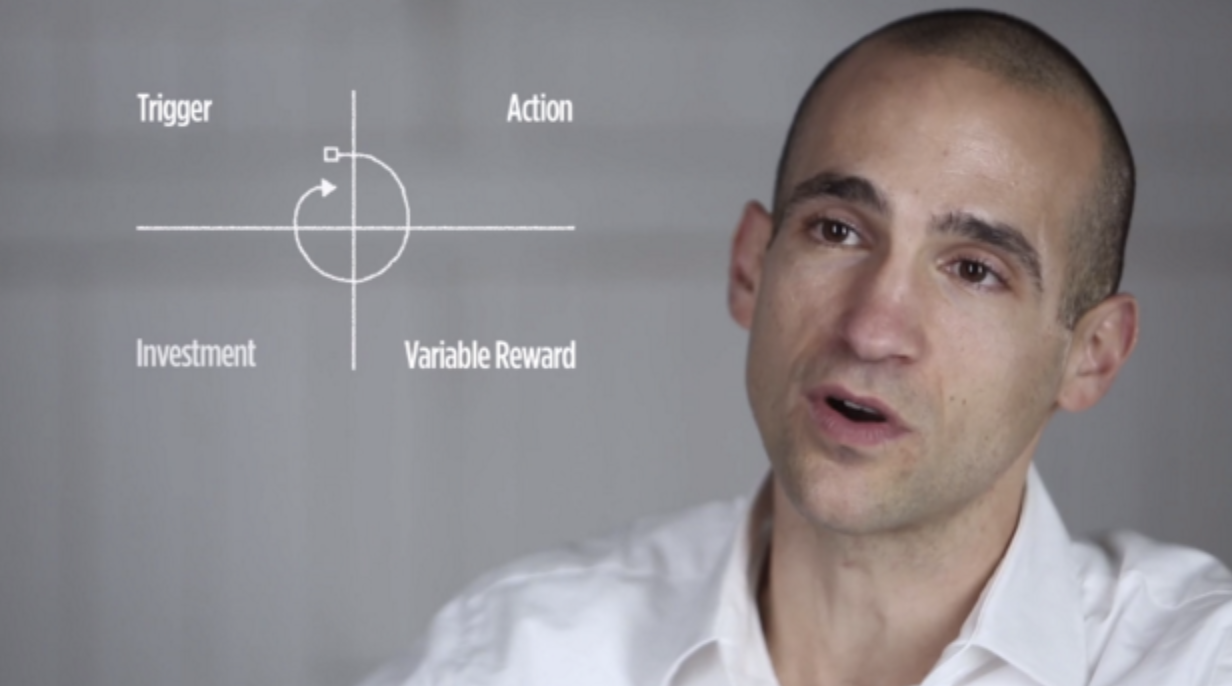
“In order to win the loyalty of their users and create a product that’s regularly used, companies must learn not only what compels users to click but also what makes them tick.”
The 4 steps of the ‘Hook Model’ by Nir Eyal:
- Trigger
Grabbing a customer’s attention through an email, a notification on their phone or an interesting image on their social feeds.
- Action
The simple action that follows the trigger and the anticipation for its reward. This is where design, UX and UI come in, the easier it is to perform the action and the more motivation they have the higher the chances of a customer repeating that action.
- Variable Reward
The heart of the ‘Hooked’ model – variable rewards increase anticipation, want and desire and key for getting your customers hooked.
4.Investment
This is where the customer takes an action and starts investing back into your product. Their investment isn’t necessarily to do with paying, it’s about taking an action that will improve the service next time they use it – inviting friends, completing their profile or earning points for certain actions. Each time they take an action they become more committed and the excitement towards the reward grows.
Creating a habit-forming product is the best way to increase customer retention and grow your business.
In fact, there is a 27% chance of a customer repeating a purchase at a store that they have purchased in before, there is a 45% chance for a third purchase and a whopping 54% chance for a fourth purchase. Surprisingly, although new visitors generate the most site visits and have the majority of the marketing budgets, on average they only generate 41% of a site’s revenue.
Statistic Source: Smile.io
With all this in mind, it is clear that customer retention is key for business growth and where the money is, yet only 18% of companies invest in customer retention. (Invesp 2020)
So, how can you take the next step to optimize your returning customers? It all starts with the three pillars of customer retention.
The 3 Pillars Of An Effective Customer Retention Strategy
It’s often thought that the sales funnel ends after a conversion. That’s nothing more than a myth.
As Alex McEachern from Smile.io says, “a repeat customer is more likely to buy from you again and again.”
The key to making these conversions possible is tapping into each customers’ post-purchase rationalization. Our purchase decisions are based on emotions and, more often than not, are irrational.
Like that time you bought a $200 shirt that you could have probably bought for $20. (Oops…was that just me?)
We go through a phase of post-purchase rationalization where we try to justify our purchases. Our responsibility here is to engage with customers and give them the option to do more so that they feel good about their purchase.
So, you’re doing three things post-purchase:
- Helping customers feel good about themselves
- Creating habits for them
- Setting the scene so that once someone takes a certain action with you, that person is far more likely to take another.
Enter the three pillars of a customer retention strategy.
Pillar #1 : Make It About The Customer
Your customer is more than the demographic characteristics we like to rattle off (age, gender, location, income etc.). Understanding our customers means paying keen attention to the emotions that drive them.
My team and I have spent years perfecting our emotional targeting methodology. I won’t go into details here because that isn’t the focus of this article. What I will say is this – emotions are what ultimately determine if your prospect believes you can solve their problem, or if your competitor can.
So, your ability to increase customer retention and loyalty depends on how well you understand the emotions that drive your customers. In other words, your focus should be on the feelings associated with your customers’ pain points and how you can address them.
Pillar #2 – Build Trust And Form Relationships
Emotions also play an important role in building trust and forming relationships with your customers. Motista, a brand that uses their trademarked Predictive Intelligence on Emotions strategy to help brands grow revenue, conducted a two year study that proves the connection between emotions and building consumer trust.
They surveyed over 100,000 US based consumers across more than 100 brands. Here’s what they discovered … “customers with an emotional relationship with a brand have a 306% higher lifetime value and will recommend the company at a rate of 71%, rather than the average rate of 45%.” (Motista Report)
One way to build this emotional connection with returning customers is to show that you remember them. Whether it’s via a cookie or the fact they signed up, when they re-enter your site they want to quickly login (using social logins or email and password) or see their previous items in their cart, even if they haven’t signed up.
Though I haven’t logged into my Skreened account (and wasn’t logged in while adding the item to the cart), days later they still know I have an item in my cart and have saved it for me.
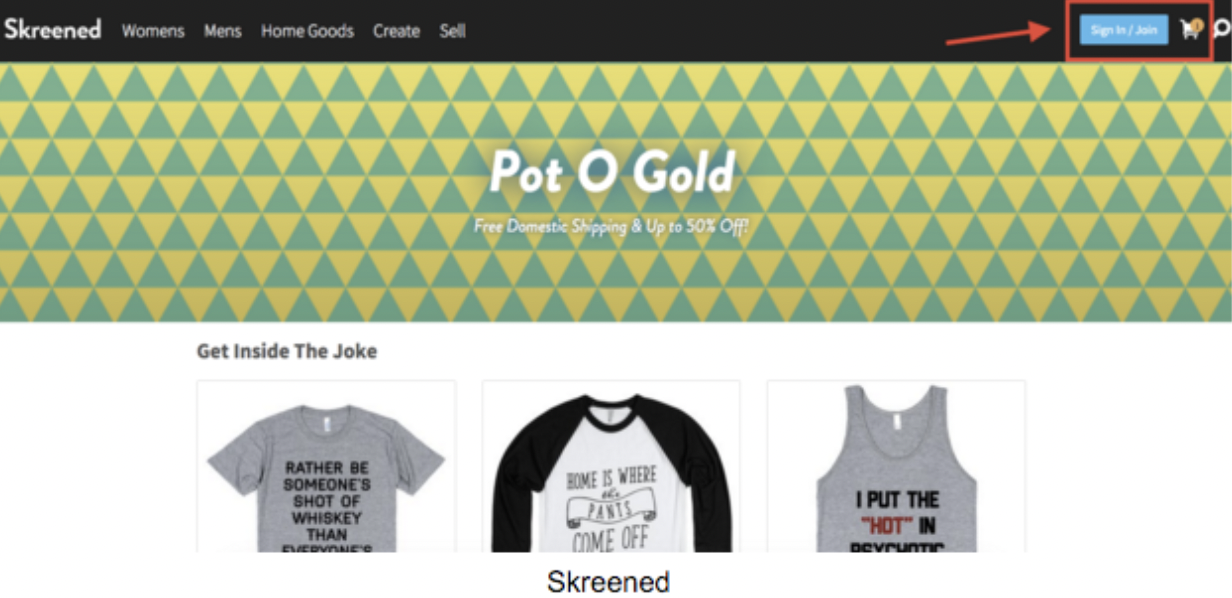
Here are some tips that can help you build trust:
- Include widgets like TrustPilot, YotPo, and others that feature reviews from shoppers.
- Continue with recommendations from past customers and reviews of products in which they have shown interest.
Here’s an example of a review left by one of my past students. This social proof helps new students build trust in me and what I can offer them.

- Include personalization.
Personalization is a great way to increase trust and enhance the sense of familiarity with customers. There’s a lot that can be said about personalization.
The most common form of personalization is providing recommendations based on previous shopping behavior. Some of the top website personalization and recommendation tools can help you provide these important recommendations.
Personalization based on previous shopping behavior shows customers that you understand their preferences. Amazon does this really well. Have you ever bought something on Amazon and then seen relevant product suggestions based on that purchase?
Here’s a snapshot of what this looks like in the Amazon account of one of our team members, Christine.

Her boyfriend is a guitarist so she’s often looking for guitar-related things. She also reads a lot and has her own podcast. So, her purchase recommendations are related to those items.
But, this isn’t the only way you can approach personalization. You can also personalize experiences for your customers based on location. Here, you would highlight products and/or content based on their geographical location, local currency, local phone number and/or local office address.
Emotional triggers can also be used to create personalized experiences for customers. Here’s a great example from Spotify.
Image Source: Campaign
This ad relates to the social image emotional trigger. Many people experienced financial loss, job loss, family loss, and a myriad of other negative things during the pandemic. This ad reminds us that we can use Spotify to listen to our favorite artistes together. After all, even Dolly Parton uses Spotify to listen to music that gets her through the tough times.
These applications of personalization contribute to a sense of safeness and the well known. More on this later on. Rand Fishkin’s approach to retaining users at SparkToro users focuses on building trust and a reliable relationship.
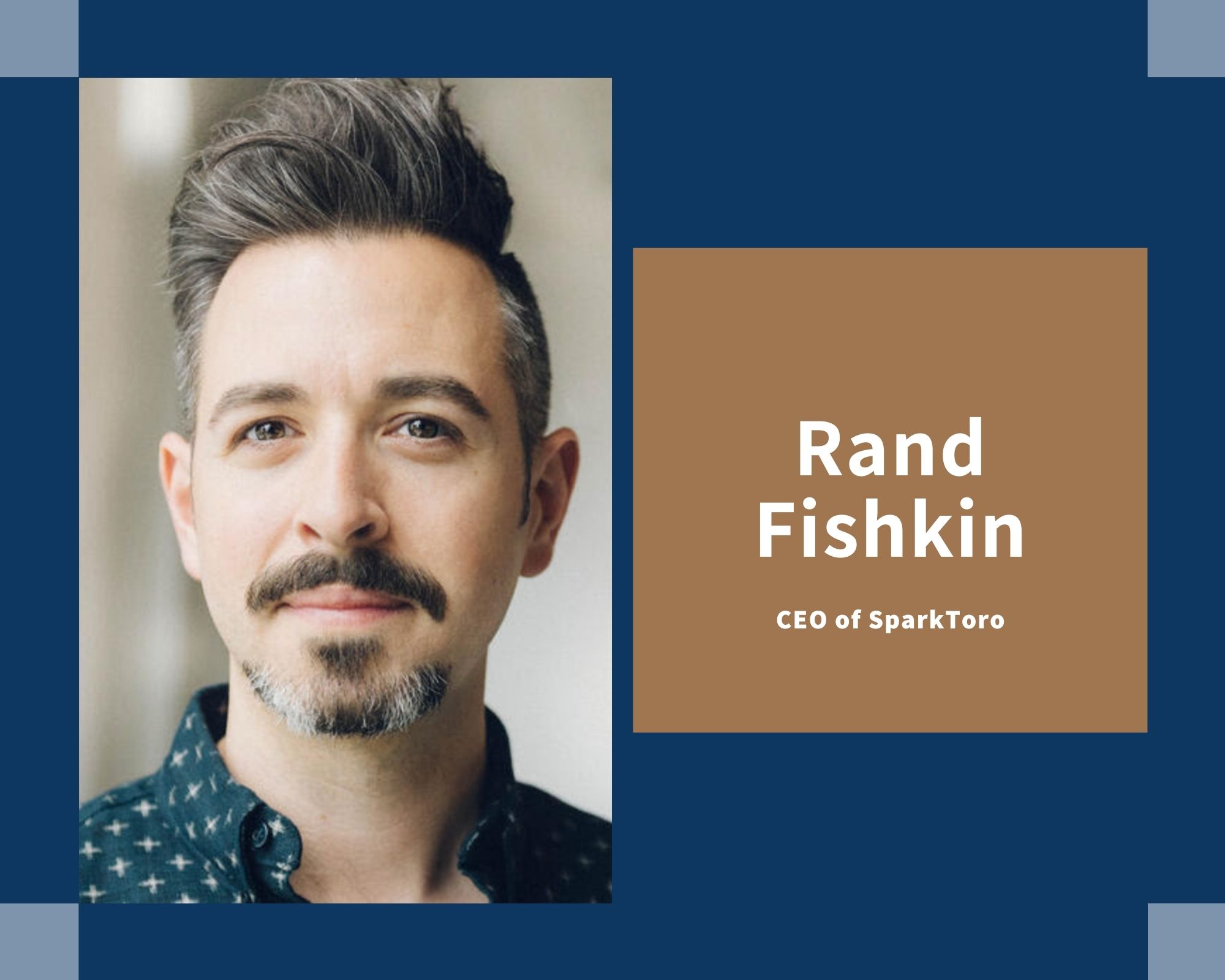
How The Team At SparkToro Builds Trust With Customers
“We have intentionally built a product that’s designed to be easy to cancel when you don’t need it and re-activate when you do. We know lots of folks only need audience research every few months or even only once a year, so we’ve built a product that makes that proposition work. We actually email before we charge your card again, encouraging you to cancel if you’re not using the product actively. We have an easy maintenance mode for folks who just want a few searches and lists each month. And we rely on re-activation and sharing of the product to create bigger lifetime value vs. just trying to force folks to stick around.”
Pillar #3 – Engage Your Customers
Denny Hollick, Director of Customer Marketing at Unbounce, has an interesting perspective on the importance of improving customer retention through customer engagement.

Engagement is a Proactive Customer Retention Strategy
“Retention isn’t a word I like to use too often because of how it focuses teams on the wrong actions. Often, their minds immediately start focusing on tactics that will prevent churn at the end of a funnel or customer lifecycle.
As an example, when you hear the title ‘retention specialist’ at a lot of companies, it’s often associated with someone who is trying to prevent customers from hitting the cancel button. This retention specialist uses tactics that are often reactionary (discounting, rectifying wrongs etc).
It’s often hard to turn things around when a customer is even considering hitting a cancel button and is at the point of needing to be retained. The customer will likely be back to cancel later even if you prevent cancellation at that moment.
There is one exception to this – preventing involuntary churn through billing challenges. I highly encourage companies to do this proactively. There are great tools that can help you do this automatically.
The most effective retention strategy isn’t focused on retention at all. It’s focused on engagement and driving customers to value throughout their lifecycle.”
You can engage existing customers in many ways. Email marketing is one of the most powerful engagement strategies you can use and we discuss that strategy later in this article.
For now, we’re going to focus on four customer engagement strategies that help increase customer retention and loyalty.
Gamification Is An Underrated Customer Retention Strategy
The offline world has been using gamification methods for years, from girl scouts trying to earn their next badge to grown men and women working hard to lose weight and gain points for it. Every element of gamification addresses the 4th step of the ‘Hooked’ model – getting them invested in your product.
Engage your customers; allow them to set goals for themselves, earn points for reviewing items, writing recommendations or sharing their purchases. You can either reciprocate immediately (a coupon for the current purchase) or build a point system that allows customers to reach a certain amount of points and get a discount on their next purchase or a free gift.
You can even launch a VIP loyalty program allowing customers to earn and redeem points to shop their favorite sales early, get discounts, free shipping, and attend exclusive events.
To get users engaged and hooked on the app, Snapchat used to offer trophies triggered by the actions people took within the app. To gain additional trophies, you had to continuously try new things, spend more time on the app which in return meant – investing time in it. People spent weeks trying to figure out how to gain additional trophies. Note the use of padlocks to generate curiosity and remind you, there are many more to discover. Unfortunately I only had 8… 🙁

Host Webinars
Webinars are great ways to add value to your audience. You can invite special guests who can teach your audience about the topics they want to learn more about.
Successful webinars:
- Cover topics the audience cares about
- Have engaging speakers
- Provide opportunities for the audience to engage and ask questions
You also have to promote the webinar so that your audience is aware
Build a Community/Group
I created a Facebook Group called We Optimize.
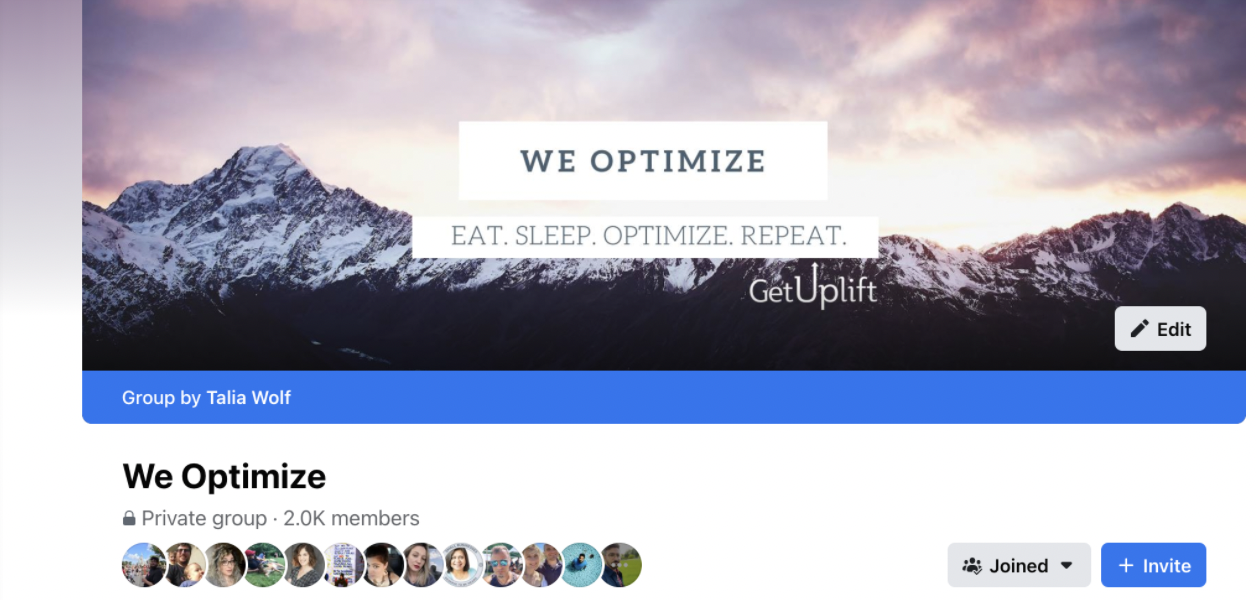
The We Optimize community is a space where everyone in the group can learn from me (and from each other) about conversion rate optimization. Members are open to seek advice, ask for feedback, and brainstorm with each other so that they can:
- Fix the leaks in their funnel
- Create websites customers LOVE to convert to
- 10X their conversions
Members of this community also read my blog posts, watch my Youtube videos, and engage with the content I share with them. You can learn more tips about building an active social media community in this article.
Offer Exclusive Content
Customers love the feeling of exclusivity. It’s a feeling that taps into their desire to boost both their social image and self-image.
First, they want to feel like they’re more important than others within the same group. Second, they want to feel good about themselves; they want to feel like they’re valued.
So, offer exclusive content to customers who meet certain criteria. The criteria you set depends on your customer base, your business goals, and the type of content you have to offer. Ultimately, you’ll create more opportunities for customers to get excited and engage.
One of my clients, iPhone Life, uses the exclusive content strategy very well. They offer a Tip of the Day subscription which provides a new iPhone tip each day. Each tip helps readers master using their iPhones and leverage all the capabilities the phones have to offer.
The Tip of the Day subscription is free to all their email subscribers. But, they also have a paid subscription called Insider that offers exclusive content for Insider members. The exclusive content includes:
- Live courses
- 1:1 chat to troubleshoot iPhone problems
- Free guides
…plus many other types of exclusive content.
Also, they release an exclusive course for iPhone, tablets and the Apple Watch every few months that their customers can add-on to their subscriptions. Customers aren’t expecting this so they’re equally delighted and excited to try out the course.
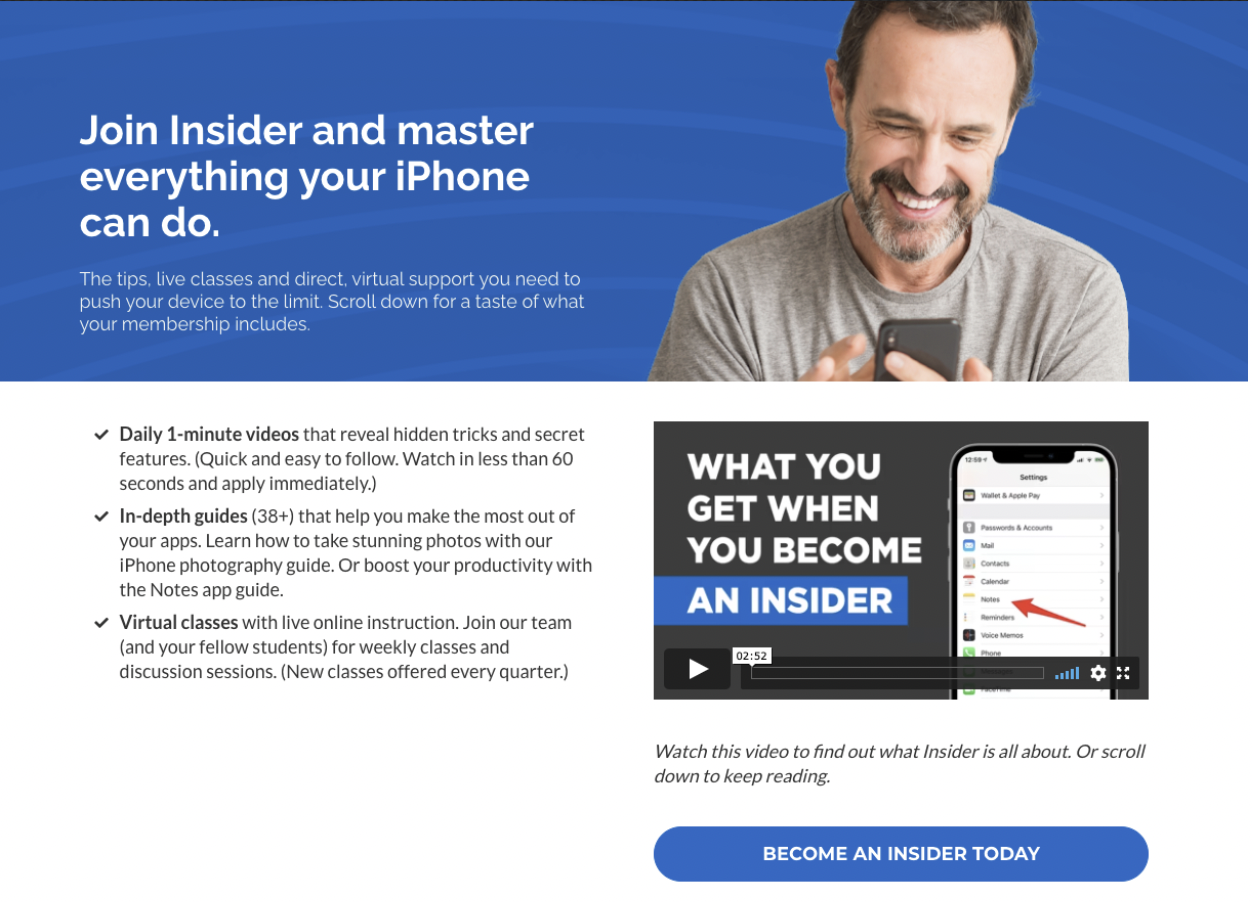
Using Email Marketing As A Customer Retention Strategy
Email marketing is the most common and effective customer retention strategy. A State of Email report published by Litmus in 2020 revealed that “77% of the marketers surveyed said that email is one of their top two most effective marketing channels.”
The power of email marketing has been felt even stronger in our post-COVID world. Now more than ever, we’re spending more time on social media and in their personal inboxes. Our social media feeds are flooded with content and can often feel noisy and crowded.
But, a personalized message in someone’s email inbox can go a long way. Your customers want to feel connected with your brand on a one-on-one level. That personalized experience is difficult to provide on channels other than email.
Email marketing can drive great uplifts in conversions and convert more one-time customers into returning ones.To get started with email marketing, you must first grow your email marketing subscriptions and optimize the quality of those signing up.
You may already be using an entry pop-up with a coupon or utilizing exit pop-ups, however there are many ways to optimize the quality of the registrations by identifying the right time and the right content to prompt.
For example, doing some extensive testing with TheNextWeb, we found that the best time to ask visitors to sign up to the newsletter was once they had scrolled over 30% of an article. By setting the pop-up to be triggered by scroll, we saw a 32% uplift in newsletter registrations on desktop.

For iPhone Life, we recently found that an exit pop up targeted at returning visitors who have seen more than two pages on the site resulted in 58.8% uplift in signups.
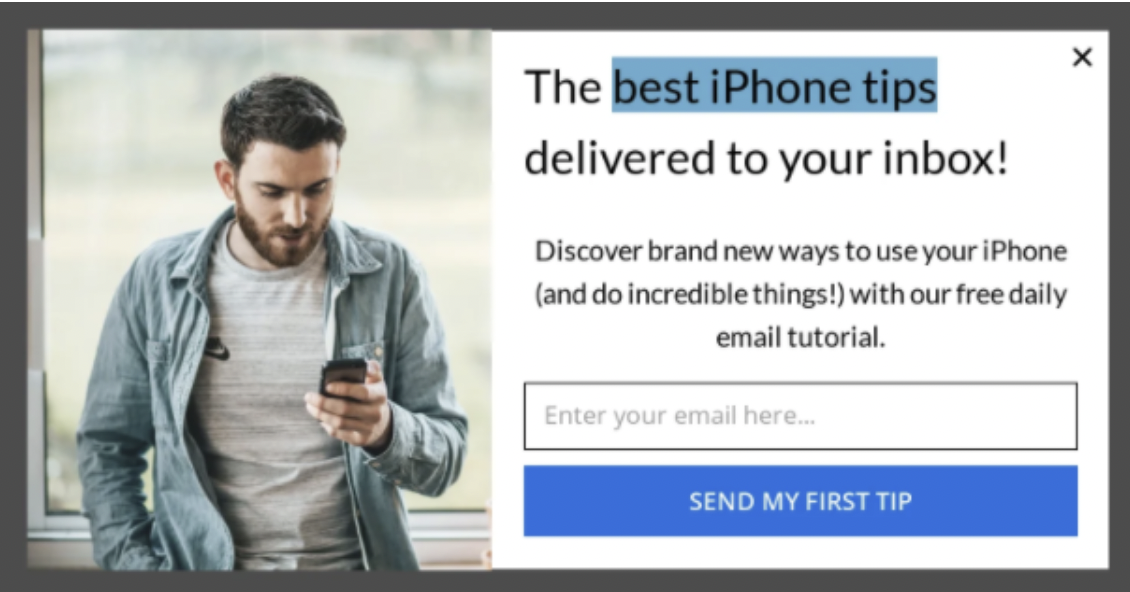
Furthermore, a mobile-specific welcome screen targeted at new visitors who view certain topics on the site and have scrolled at least 30% of a page has (at the time of writing this post) almost 20% more conversions than the desktop variation.

Once you have the right people signing up to your newsletter, you can then start optimizing the content of your newsletters to increase customer retention and further create a connection with your customers.
7 Ways To Increase Customer Retention Using Email Marketing
Post-Purchase Email
After making a purchase, we’re are at the peak of excitement and anticipation towards receiving our product. This is why sending an email detailing your customer’s purchase, saying “Thank you for buying”, and offering a way for customers to stay engaged with your brand and gain more can go a long way.
For example, CheapOAir once used their thank you email to offer 20% off a customer’s next flight.

Here’s another example.
I recently purchased something from Flowjo and then received an email asking for my review of their wonderful product. These kinds of emails are perfect for making a connection with your customer (showing them you care) and utilizing the foot in the door technique that basically means that since I’ve already taken one action (purchased from them), I’m far more likely to take another.

Progress Emails
As we’ve established, increasing customer retention is all about building trust and enhancing the connection with your customer. In addition to letting your customer know their shipping status, there are many other updates you can send such as:
- The production of the product
- Packaging updates
- Pictures of your smiling staff happy to be working on their product
These types of emails can benefit you on many levels.
- Increase the sense of trust and set customers at ease – “This is a reliable company and my package is on its way.”
- Create a stronger connection with your customers by introducing them to your staff and process and increase the sense of loyalty to your brand.
- Keep excitement and anticipation at peak. There is a timeframe between buying a product and receiving it that consumers start second-guessing their purchase decision. Many times this happens with products that are purchased online and are not received immediately. Sending customers pictures of the team at work or even just waving “their” package off, keeps customers excited and happy with their purchase.
The Dollar Shave Club offers customers a chance to add additional items to their package before being shipped. A simple email notifying customers of the shipping date plus additional products customers may want to add in their bag before it’s too late.
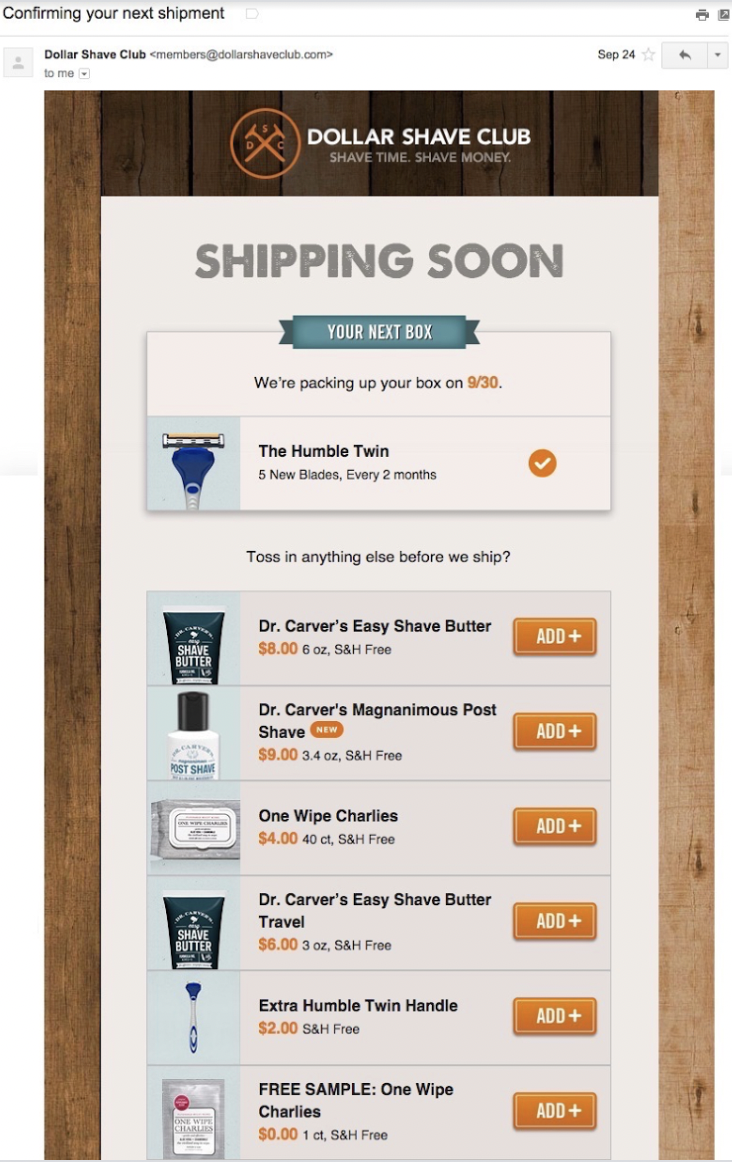
Leverage Loss Aversion
There’s just something about emails that say “24 hours only sale” that make people (including myself) stop what they’re doing and open that email.
We may not need these products and we probably weren’t even thinking about buying anything. However, somehow they’ve grabbed our attention.
Limited time sales create a sense of urgency in customers and trigger loss aversion which refers to people’s tendency to strongly prefer avoiding losses to acquiring gains.” In fact, most studies suggest that the discomfort we feel with loss is twice as powerful as the pleasure in gain which is why we try to avoid loss at all costs.
You can utilize this trigger by sending weekly reminders to your customers of your sales and special offers. Don’t forget to highlight the timeframe and importance of completing a certain action at a certain time.
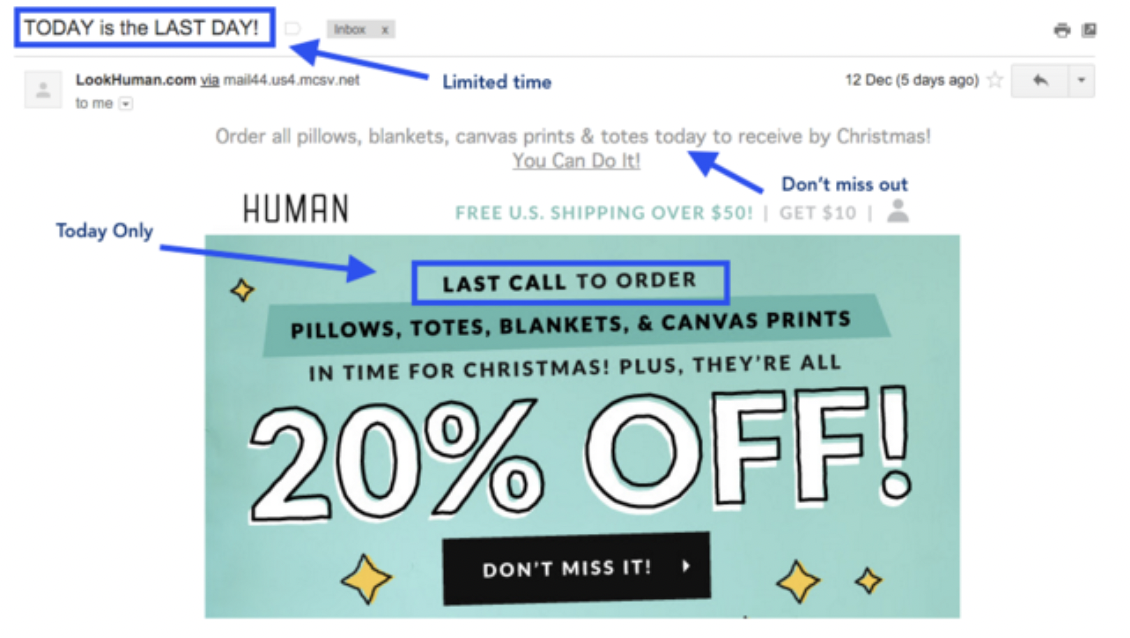
Build Brand Ambassadors Using Hyperbolic Discounting
As “Hooked” explains, in order to form habits within our customers, they need to make an investment. A great way to do this is by rewarding customers for spreading the word and turning them into brand ambassadors.
In the example below, ‘theSkimm’, a daily email subscription service engages their community, turning them into brand ambassadors by offering swag in return for promotion and sharing their service with friends.

Another common way of turning customers into brand ambassadors is by offering special coupons to customers who spread the word to their friends. However, while planning these rewards for your customers, consider the fact that given two similar rewards, people show a preference for the one that arrives sooner rather than later. This is commonly referred to as the “Hyperbolic Discounting’ bias which means that it is crucial to offer customers realistic deals that seem close and easy to fulfill.
It’s important to remember this principle if you want to increase customer retention.
Master Personalization
Personalization is the name of the game. Here are some crazy stats about personalization that will blow your mind.
- 56% of customers stay loyal to brands that “get them” (SmallBizGenius)
- 50% of U.S. consumers have left a brand they were loyal to for a competitor that better met their needs (HubSpot)
- 87% of Americans are willing to have various details of their activity tracked in exchange for more personalized rewards and brand experiences (Bond Brand Loyalty)
Your customers want you to show that you understand who they are, what they like, and what they want to learn. So, get to know your customer’s habits, tastes and desires. That’s how you’ll gain loyal customers. By simply tracking your customer’s purchase record, you can offer suggested items, new products from the same category, or similar items.
Other than sending customers personalized suggested items to their mailbox, One King’s Lane also uses the power of scarcity to increase sales. The thought that we may lose out on this nightstand will probably motivate us to purchase it based on the principles outlined in Cialdini’s 1984 book “Influence”.

Pinterest sends personalized emails that connect you to other users who “pin” the same stuff. These emails help enhance the sense of community.

Leverage the Social Identity Theory
The Social Identity theory suggests that our self esteem and identity are derived from the social groups with which we identify. Being part of a group allows us to differentiate between “them” and “us” and allows us to identify with brands and groups.
We define ourselves according to the social groups around us and stuff that we own. The higher a group ranks, the more we want to be a part of that group. Presenting yourself as a community in your emails, inviting people to join you on Facebook, Instagram and other social platforms enhances the sense of commitment to your brand.
In the example below, Nextdoor establishes itself as a private community. Only certain people are invited to participate in the community.

Leverage Your Onboarding Emails
Retention starts right from the get go.
Every email you send your customers has the potential to increase lifetime value and impact their habits, even in SaaS.
Your onboarding emails are crucial to the success of your customers and will have a direct impact on whether people continue to use your product or not.
As Georgina Laudi, co-founder of Forget The Funnel explains…

The Power of Your Onboarding Emails
SaaS founders are obsessed with leads but neglect to understand that a simple 5% increase in retention can lead to a profit increase of up to 95%. If you love low hanging fruit with a big payoff, you need to focus on fixing your customer onboarding. This can have an outsized impact on your revenue.
Your onboarding emails affect that critical point between becoming a lead (free or trial signup) to reaching that critical moment of real value in your product.
You need to hit the right notes for your customers during their onboarding and set your customer and business up for a higher lifetime value for both of you. To do this you need to know:
- What led them to seek out a solution like yours?
- What current solution are they “firing”?
- What motivations & objections need to be addressed?
- What does success look like for them?”
Key Customer Retention Analytics You Should Pay Attention To
There are several ways to approach the customer retention analytics that matter.
Rand Fishkin, CEO and Founder of Sparktoro and his team look at the customer’s journey and specific actions customers take that increase engagement with their tool.

How Rand Fishkin Approaches Customer Retention Analytics
- Percent of (free) signups that have reached an “aha!” moment milestone (like running out of free searches or making their first list in the product)
- Percent of (paid) signups that have used key features in the paid version (list building, exporting, comparison searches, different search formats, etc)
- Percent of folks (free and paid) that have engaged with our product-focused content, in particular our bi-weekly SparkToro webinars
- Percent of (paid) signups that churn each month, and those that re-activate.”
Denny Hollick, Director of Customer Marketing at Unbounce, shares an interesting perspective on the customer retention metrics that matter most. His team focuses on engagement.

Focus on Engagement
“When it comes to typical ‘retention metrics’ (LTV, Churn, etc), while important for a business to understand the health of its customer base and build strategies to improve them, they are lagging indicators. It often takes significant time to see how your inputs can affect customers. There are also many conflating factors which could make it difficult to measure the direct impact.
So, instead, for the teams working on improving retention, a retention metric should be measured more as a leading indicator that they can directly affect and measure, long before a customer hits the cancel button.
There is a VERY clear correlation between customers that hit the cancel button and their level of engagement on our platform at Unbounce. Engagement is a direct proxy for value created for our customers and, ultimately, will show up in our retention metrics. As a result, I prefer to focus my teams on ensuring that customers are receiving value in the first place, and engaged in our product.
Thus, the retention metric we focus on is called “Weeks of Engagement” which is how many weeks, out of the trailing 4 weeks, a customer engaged with a core action in the Unbounce platform that is a proxy for customer value being created. Previously before this metric evolved and we became a multi-product company, we measured this by how often customers were publishing landing pages.
We then categorize those customers into 4 groups: Power Users, Core Users, Casual Users, and At-Risk Users. Each of these cohorts is a proxy for the level of value that they ultimately receive, and our goal is to increase the level of value each gets so the cancel button isn’t even on the radar for them in the first place.
The majority of the tactics that we pick are focused on bringing users from those At-risk categories, to Casual, and Casual to Core. We do this through experimentation; we develop a hypothesis, test it, measure it, and see what effect it has on engagement.
In summary, the most effective retention strategy isn’t focused on retention at all. It’s focused on engagement, and driving customers to value throughout their lifecycle.”
Anuj Adhiya, Growth Advisor at Global Work, analyzes retention for his clients through time and specific events.

Customer Retention Metrics Based On Time & Specific Events
I look at retention in 3 stages.
- Stage 1
a.Day 1 retention: The number of unique users who came back to the app and performed x events (measure of “active”) the next day after signing up
- Day 1 % = Number of users who came back to the app and performed X events (measure of “active”) on day 1 divided by the number of users who signed up on day 0.
- Similarly,we calculate the same for Day 7.
- Stage 2
Weekly retention calculated similarly to how Day 1 and Day 7 (and their percentages) are calculated.
- Stage 3
Percentage of users that are active 3-6 months post signup.”
Pro Tip: Leverage The Thank you Page As Part Of Your Customer Retention Strategy
We just spoke about the value of email marketing in a customer retention strategy. But, we never dived into one of the most underutilized aspects of an email marketing strategy – the thank you page.
Oftentimes, brand’s view the thank you page as an afterthought, nothing more than a quick way to let people know they’ve successfully subscribed.
Here’s an example.
Jade Black is an eyewear company that sells luxury glasses at affordable prices. This is what their email subscription looks like.

It’s just a small box at the bottom right-hand corner of the page. It seems as though the email subscriber list isn’t given much priority based on where the sign-up form is positioned, how it’s designed, and how easy it is to overlook with everything else happening on the page.
Anyone who subscribes sees this lackluster thank you message.

That’s it. Nothing more is done to encourage subscribers to browse the website or engage with their content.
That’s a huge mistake! The truth is that Jade Black isn’t alone; there are several other websites that approach email marketing in this lackluster way.
On the flip side, Jennifer Welsh and Jay Clouse use their thank you pages strategically to help increase their course sales.
Jennifer Welsh creates great content that makes the stock market and personal finance easier for people to understand. This is what her email subscription page looks like.

She has enabled double opt-in for her email subscriber list. So, subscribers get this follow up message that directs them to check their inboxes to confirm their subscriptions.
This is an important strategy because it helps her qualify her subscribers, reduce spam accounts, and continue the engagement process.

The confirmation is followed by this page.
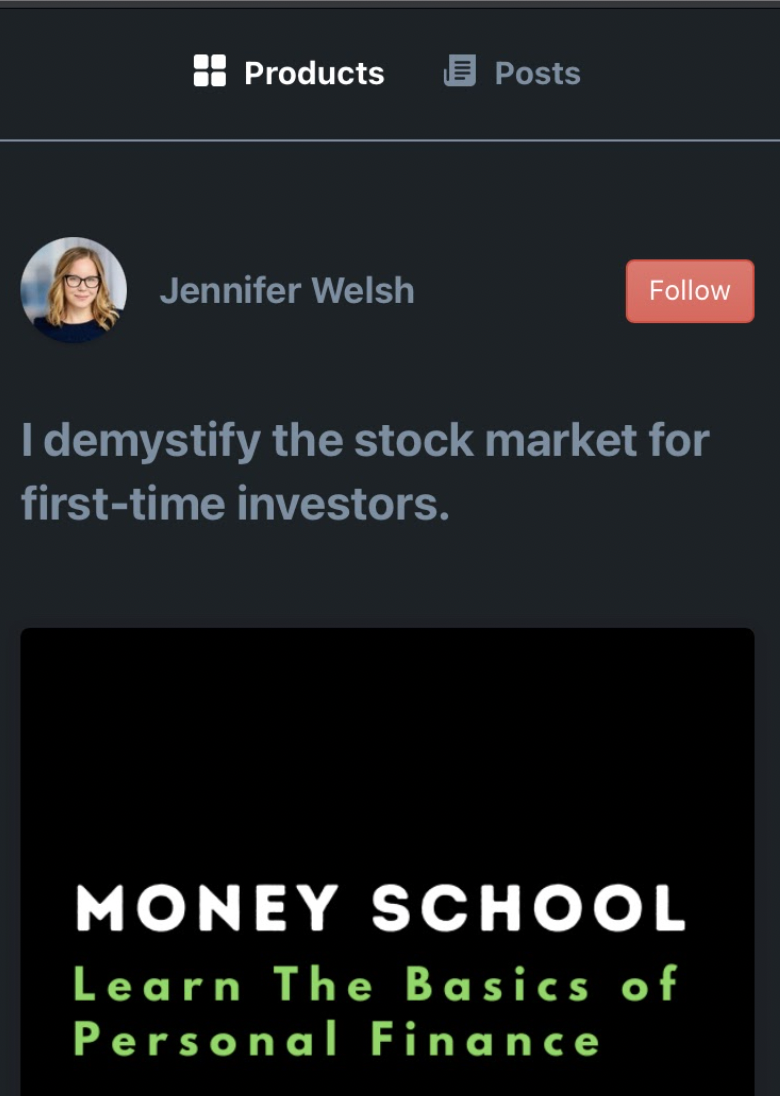
Jennifer does two important things here:
- She encourages you to follow her so that you never miss updates.
- She showcases all her recent products and posts. So, you can choose to purchase her product immediately or engage with more of her content using the Posts tab.
Brilliant!
Here’s another great example from Jay Clouse’s Freelancing School.
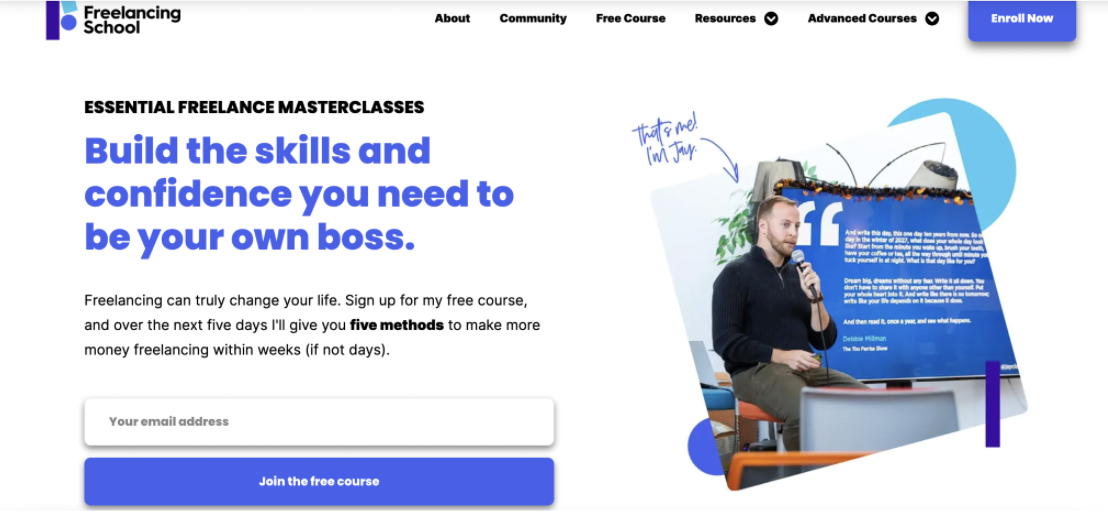
Subscribers get a free course when they sign up. After they opt-in, they receive this message.
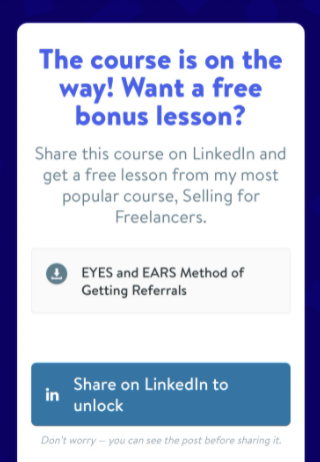
Jay doesn’t use the words “thank you” on his page, but he’s saying thank you to his new email subscriber by providing even more value. This thank you page provides a free bonus lesson and the opportunity to share this exciting deal on LinkedIn.
These two examples show that the thank you page provides a great opportunity to further engage prospects!
There are five main ways that you can increase customer retention using thank you pages. Jay and Jennifer used a few of them. You can use one, or a combination, of these tactics to increase conversion rates and even turn your new subscribers into brand advocates.
1. Validate Leads (High-End Leads)
Some of the people who subscribe to your email list can become high-value leads. But, how can you identify these people?
Get more information about your new leads by asking questions. Here are some questions that you could ask:
- What’s the biggest challenge you’re facing right now?
- How would you like to be contacted for a follow-up (phone, email etc.)?
- What content have you shared most recently?
- What’s the best time to contact you?
- What’s your position at your company?
Here’s an example of a thank you page we created for one of our B2B clients.We wanted to build a personal connection with these prospects. So, not only did we ask questions but we also included an image and personal note from one of the co-founders of the business, Carolyn.

This change may seem small and simple, but it had a major impact on the company’s bottom-line. The quality of the leads the company got increased and the sales team was able to increase direct sales by 52%.
2. Build Trust
The best way to build trust with people who have never met you before is to use social proof. You’re tapping into the wagon effect. As Robert C. Kelly states, “The bandwagon effect is a psychological phenomenon in which people do something primarily because other people are doing it, regardless of their own beliefs, which they may ignore or override. “
You’re more likely to retain new customers if they see proof that other people have purchased from you and have enjoyed the experience. Think about the last time you purchased something. Chances are you checked out the reviews before finally deciding to purchase.
InfusionSoft has a good example of this. They showcase some of their best customer testimonials on their thank you page to help prospects validate their choice.

Here’s another example from Greenhouse.io. This example is a bit different. Instead of providing testimonials, Greenhouse.io shows downloadable guides and articles prospects can download for free.

Greenhouse.io can then use customer behavior on this page to segment email subscribers based on their interests. These free content assets also increase trust in the brand because prospects feel like they’re getting immense value for free.
Let me emphasize that point. This tactic only works if your content provides immense value. People won’t trust a brand that provides them with substandard content.
Here’s yet another example from Litmus. You’ll see this page after downloading their 2020 State of Email report.

Litmus has used three techniques:
- Social Proof through highlighting top brands that have used their software
- Highlighting content relevant to the download
- Inviting the new email subscriber to view plans and pricing
Subscribers who feel like they trust the brand enough may just click through to view the plans and pricing and ultimately become paying customers.
3. Survey
I use a survey on the thank you page for GetUplift’s free email marketing course.

Anyone who completes the signup form is directed to a survey on my thank you page. This survey helps me learn more about the subscriber’s pain points and, therefore, the type of content that would resonate with each of them.
In other words, the survey helps me segment my email subscriber list so that each subscriber can get a more personalized experience.
When I use this survey approach with my clients, I tend to ask some variation of these questions:
- What prompted you to sign up?
- What was the biggest problem that led you here today?
- How do you think we can solve your problem?
- What almost prevented you from buying today?
The responses provide a wealth of information that can help you quickly optimize your funnel because you get insights into the emotions that drive your customers’ purchases.
Here’s another example from Floppi. They only ask one question – why did you sign up for Floppi. But, they incentivize the process by giving those who answer priority on their waiting list.

4. Social Shares
Jay Clouse’s course sign up is an example of how the thank you page can be used to increase social shares. But, here’s another interesting example from CountryOS. They use bumping the subscriber up the list as a way to incentivize sharing the email on their social media channels.

This strategy works up to a point though. CountryOS has millions of people on their waiting list so a 100-point bump won’t make a huge difference. So, if you’re going to try this strategy, you have to watch the numbers to ensure that the incentive is still worthwhile.
Poppins is another example of how social shares can be used effectively on a thank you page. You can get faster access to the Poppins platform if you invite three friends.
What’s great about their approach is that they don’t leave it up to the subscriber to decide. Instead, they use a concept called anchoring bias by encouraging the subscriber to invite a specific number of friends.
Put simply, anchoring bias relates to our tendency to use the first bit of information we get to make our decisions. So, Poppins encourages people to invite at least three people and this number becomes the anchor.

Tookapic is another good example. They offer a free T-Shirt to anyone who shares the page.

Wanna try this for your brand? You could use Kickoff Labs’ Giveaway Campaign software or Prefinery’s referral software.
Wanna do this on your thank-you page? Solutions like KickoffLabs make shareable thank-you pages a breeze. And Prefinery does something similar – Copyhackers is using it for Airstory.
5. Special Promotions
You may have some special deals for new subscribers. Showcase those deals on the thank you page.
We call this the foot in the door technique. Potential customers have already trusted you enough to hand over their contact details. Now, you can tell them more about your paid offer and encourage them to take the next step, just like we do for iPhone Life.
After subscribing to Tip of the Day on the iPhone Life website, the thank you page invites you to check out a special promotion offer for a course.

6. Lead People To The Next Step In The Funnel
Help your new email subscriber understand what to do next. For example, you may need to show your subscriber the steps to download your product or how to complete the double opt-in process.
Here’s an example of a thank you page we created for a client. We showed exactly what they should do once they downloaded the product.

A simple call to action and an arrow directing customer attention to the next step helped increase implementation of the product by 39%.
Taking Your Next Steps To Increase Customer Retention
Customer retention helps you connect with your customers. It helps you understand more about them so that you can build emotional connections with them. The key to customer retention is reaching out to customers on an emotional level and connecting with them to create better user journeys, a better product and grow your business.
Take a moment and ask yourself, are you doing everything you can to increase customer retention?
Facebook Comments
Powered by Facebook Comments


